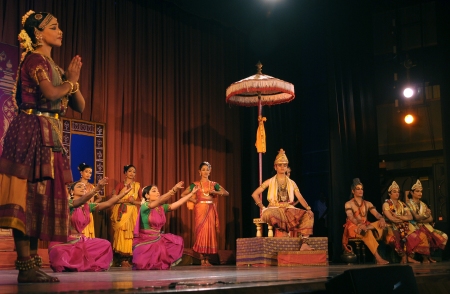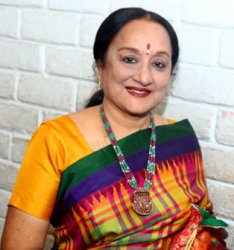
|   |

|   |
Dance Drama May 7, 2014 The term 'dance drama' is peculiar to Indian classical dance, particularly Bharatanatyam. The core idea of combining dance with a purely theatrical performance in which a story unfolds with each character played by a different actor can be traced to the Natya Sastra, at least for the sake of dating it. Ancient Sanskrit theatre subscribed to this concept, in which not only dance but also music played a vital role. Theatrical space was as important in ancient India as costume and make up. Writing for that classical theatre art known as NATYA was the challenge met by several medieval Sanskrit dramatists and poets. In Tamil Nadu, as early as the time of Raja Raja Chola, Natakams in which women also participated took place in the temples. Raja Raja Natakam and Manmatha Natakam were enacted in the Brihadeeswara temple.  Kalakshetra's Sita
Swayamvaram
Photo: Thanthoni In the early twentieth century of rediscovering many lost performance disciplines, new forms emerged to suit urban audiences. In Tamil Nadu, the star innovator was Rukmini Devi who had seen ballet with a story line while traveling abroad. She looked for a suitable parallel to stage in her own institution. She found the Bhagavatamela natakams replete with music, narrative and dance ideal to adapt. She also found the old Kuravanji natakams interesting to adapt. With her own inputs in stage craft she began her journey in 'dance drama' productions. Today innumerable productions abound in the Bharatanatyam idiom. Surprisingly a new Ramayana series in Bharatanatyam has not been produced by anybody after Rukmini Devi. There have been a few dance dramas produced by dance schools which worked well in a limited way because to me they looked like sincere efforts, but not really impressive when it came to artistic standards. Stories from the classics are still the most popular. The variety of myths whether it is about Krishna, or Shiva or Muruga find their way to the stage. This current avatar of dance drama has no spoken word. Unlike Rukmini Devi who relied on Valmiki's Ramayana for her series, and sometimes included the spoken word, today songs are composed and tuned to suit the narrative. What artistic value do these productions have? That question will probably get a mixed response. While concepts are well chosen, many a time the production falters in choreography and aesthetics. People do not understand the term choreography. Showmanship works only up to a point. A star dancer can hold a show together. A populist narrative of myths holds the audience, but the quality of stage craft, technique of dance and skill in arranging groups of dancers in visually interesting and meaningful formations, with a fair amount of acting the parts, fall way short of excellence. There seems to be a lack of seriousness in the way it is put together. I often wonder why teachers produce such hurriedly conceived shows. Why is the scripting of the show so ad hoc and awkward? Why are the dancers thrown into roles as if they are joker cards who can fit into any role? The music is most often quite pleasing to the ear. But the lyrics are rather simplistic and devoid of any poetic merit. To me it feels like an influence of Therukoothu.... where colloquial phrases abound and the lyrics are like simple folk songs. But that is another discipline altogether. Rukmini Devi did not dress girls as males in her productions. Seventy years later, there should be a population of male dancers to play roles. Yet dance teachers who have no male students make their tall rather chubby girls play the male roles. It just does not work and I feel sorry for these girls because they are so sincere in their attempts. The effect is that of a girls' school annual day culturals. It certainly is not like a Shakespearean retro production where cross dressing was a natural aspect of drama in the Elizabethan era. If casting is a challenge, costuming is even more so. I have seen shows supported by grants where dancers just wore random old costumes from their wardrobe and thought using some accessories was "costuming." Dancers should strive for a "look" if they are ambitious about producing a new show. They need designers. We are forced to forget about sets. It is expensive and cumbersome. I know because I did several group shows in Chennai in a month, and we used only a backdrop prop, but even that needed serious supervision to be carted from one venue to the other and installed in time. Lighting needs to be worked out with a designer. Drama can be achieved with lighting and no props at all. The stark truth is there is no funding for productions. It is a catch situation where artists have to find sponsors and then go for publicity and market their work. All that takes precedence, I think, over the creative aspect. Glitzy shows can attract a crowd. But such shows are personality oriented and do not seem to pass the full test of aesthetics. At least my standards! I do wish we could have a dance drama choreography course for aspirants. Teachers need to study this subject before putting together shows. A team is needed to work on a subject and the inputs of many experts can throw light on the process. Extensive rehearsals alone cannot ensure a great production. The substance of a production is important. And the script needs proper tailoring. Most of what I have seen in recent times except some which at least seemed original, are forgettable. It is summer time....perhaps it is a time for the so called directors and choreographers to sit and think of ideas. They need guidance from perhaps theatre directors? Give the project time to grow before launching it.  Lakshmi Vishwanathan, a prime disciple of Guru Kanjeevaram Elappa Pillai, is an exponent of the Thanjavur style of Bharatanatyam. She is also a trained vocalist. She is the author of several acclaimed books: Bharatanatyam - the Tamil Heritage, Kunjamma - Ode to a Nightingale, Kapaleeswara Temple, Women of Pride -The Devadasi Heritage. Her film 'The Poetry of Dance' was commissioned by the Festival of India. The Mamallapuram Dance Festival started in 1991 was Lakshmi's brainchild. She has served on several arts committees. She has served as Vice President of Music Academy (Chennai) and is a member of South Zone Cultural Centre. Comments * Iyal, Isai and Natakam were part of the South Indian culture and they did not play much of a role in a classical style in the Vedic culture although there were numerous mentions of the celestial dancers like Menaka and Urvasi in the Vedas. For thousands of years, it was the temple residing and highly accomplished Devadasis in South India, particularly in Tamil Nadu, who preserved, maintained and also developed the musical dance forms of the classical stories with sponsorships coming from the kings themselves. - Anon (May 13, 2019) Post your comments Pl provide your name and email id along with your comment. All appropriate comments posted with name and email id in the blog will also be featured in the site. |